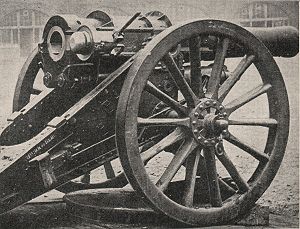BL 6 inch 30 cwt howitzer
| BL 6 inch 30 cwt Howitzer | |
|---|---|

With breech open, circa. 1900
|
|
| Type | Medium howitzer |
| Place of origin | United Kingdom |
| Service history | |
| In service | 1896 - 1918 |
| Wars |
Second Boer War World War I Greco-Turkish War (1919–1922) |
| Production history | |
| No. built | 120 |
| Specifications | |
| Weight | 7733lb (3507kg) |
| Crew | 10 |
|
|
|
| Shell |
Lyddite : 122 lb 9 oz (55.59 kg), later 100 lb (45.36 kg); Shrapnel : 100 lb (45.36 kg) |
| Calibre | 6-inch (152.4 mm) |
| Recoil | Hydro spring, 18 inch |
| Carriage | Wheeled, box trail |
| Elevation | -10° - 35° (wheeled carriage) 35° - 70° (siege mount) |
| Muzzle velocity | 777 ft/s (237 m/s) |
| Maximum firing range | 5,200 yds (122lb 9oz shell, on wheeled travelling carriage); 7,000 yds (122lb 9oz shell, on siege mounting) 7,000 yards (100 lb shell, on wheeled travelling carriage) |
The Ordnance BL 6 inch 30cwt howitzer was a British medium howitzer used in the Second Boer War and early in World War I. The qualifier "30cwt" refers to the weight of the barrel and breech together which weighed 30 hundredweight (cwt) : 30 x 112 lb = 3360 lb. It can be identified by the slightly flared shape of the muzzle and large recuperator springs below the barrel.
Introduced 1896, based on an Indian Army design.
Its original shell was 122 pounds 9 ounces (55.6 kg) Lyddite explosive. In 1901 a lighter 100 lb (45 kg) shell was introduced which increased maximum range when firing from its wheeled travelling carriage to 7000 yards. These were then referred to as the "heavy" and "light" shell respectively. A 100 lb shrapnel shell was also available.
It was phased out and replaced by 6 inch 26 cwt howitzer from late 1915 onwards. Also, in 1915 it received barrel, breechlock, recoil system and ammunition upgrade increasing its maximum range to 10400m (8400m with standard ammunition).(See specifications)
This gun was designed as a siege howitzer firing a special 122 pounds 9 ounces (55.59 kg) howitzer shell. It was designed to be fired from a static siege platform, with wheels removed, for accurate long-range shooting. When fired mounted on its normal wheeled travelling carriage, which had become standard practice for modern medium artillery, its range and accuracy diminished due to limited elevation and also lack of a modern recoil mechanism.
12 Guns were employed in South Africa in the Second Boer War as part of the British siege train. It was during this campaign that the short range limitation became evident, and shell weight was traded for greater range in 1901 with the introduction of a "light" 100 pounds (45.36 kg) shell which increased maximum range when firing from its wheeled travelling carriage to 7000 yards. No use was found for the siege platform which allowed elevation to 70° : "This capability was designed for distinct siege operation, and in South Africa the need for this did not arise. In this theatre the platform was an encumbrance, and it was discovered that it could be dispensed with".
...
Wikipedia
